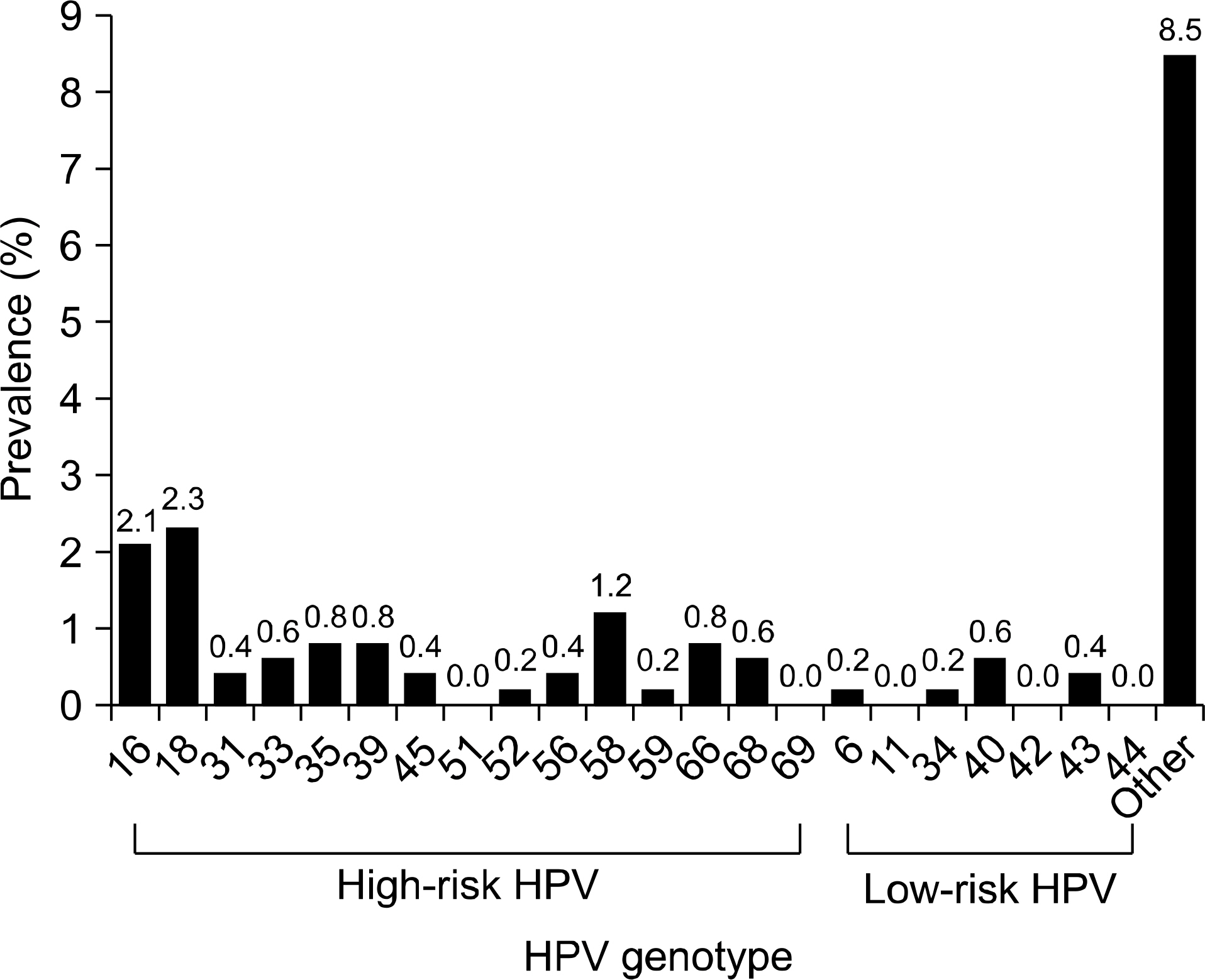Ann Clin Microbiol.
2013 Jun;16(2):87-91. 10.5145/ACM.2013.16.2.87.
Prevalence and Genotype of Human Papillomavirus Infection and Risk of Cervical Dysplasia among Asymptomatic Korean Women
- Affiliations
-
- 1Department of Laboratory Medicine, Seoul National University Hospital Healthcare System Gangnam Center, Seoul, Korea.
- 2Department of Laboratory Medicine, Seoul National University Boramae Hospital, Seoul, Korea. jeannie@snu.ac.kr
- 3Department of Laboratory Medicine, Seoul National University College of Medicine, Seoul, Korea.
- KMID: 1431770
- DOI: http://doi.org/10.5145/ACM.2013.16.2.87
Abstract
- BACKGROUND
The persistence of infection by high-risk human papillomavirus (HPV) may lead to cervical cancer. Recently, the American Society for Colposcopy and Cervical Pathology (ASCCP) announced that oncogenic HPV screening and the PAP smear are the main methods of screening for cervical cancer. The goal of this study was to investigate the prevalence and genotyping of HPV, as well as the risk of cervical dysplasia.
METHODS
HPV genotyping was conducted by a commercial chip assay. Cervical dysplasia was retrospectively reviewed using electronic medical records. The study participants were grouped together according to cervical dysplasia status: 'no dysplasia,' 'atypical squamous cells of undetermined significance (ASCUS),' 'low-grade squamous intraepithelial lesion (LSIL),' and 'high-grade squamous intraepithelial lesion (HSIL).' The HPV prevalence and genotyping were analyzed according to the cervical dysplasia group.
RESULTS
The overall prevalence of HPV was 17.6% (91 out of 518 patients). HPV-18 (2.3%), HPV-16 (2.1%), and HPV-58 (1.2%) were the three most frequent genotypes. The prevalence of HPV infection and the high-risk HPV positive rate was higher in the ASCUS, LSIL, and HSIL groups than in the no dysplasia group (P<0.05).
CONCLUSION
In this study, basic data regarding the prevalence and distribution of HPV genotypes were obtained. Since HPV vaccination has been actively encouraged among Korean women, a change in the prevalence of HPV and cervical dysplasia is expected in the future. This study provided basic data describing the prevalence of HPV and its genotypes in the pre-HPV vaccination era.
MeSH Terms
Figure
Reference
-
1.Statistics Korea. Incidence and mortality of cancer in Korea. http://www.index.go.kr/egams/stts/jsp/potal/stts/PO_STTS_IdxMain.jsp?idx_cd=2770&bbs=INDX_001. [Online] (last visited on 24 October 2012).2.Clifford GM., Smith JS., Aguado T., Franceschi S. Comparison of HPV type distribution in high-grade cervical lesions and cervical cancer: a meta-analysis. Br J Cancer. 2003. 89:101–5.
Article3.Kim YT. Current status of cervical cancer and HPV infection in Korea. J Gynecol Oncol. 2009. 20:1–7.
Article4.Bae JH., Lee SJ., Kim CJ., Hur SY., Park YG., Lee WC, et al. Human papillomavirus (HPV) type distribution in Korean women: a meta-analysis. J Microbiol Biotechnol. 2008. 18:788–94.5.Rhee JE., Shin MY., Kim CM., Kee HY., Chung JK., Min SK, et al. Prevalence of human papillomavirus infection and genotype distribution among high-risk Korean women for prospecting the strategy of vaccine development. Virol J. 2010. 7:201.
Article6.Shin HR., Franceschi S., Vaccarella S., Roh JW., Ju YH., Oh JK, et al. Prevalence and determinants of genital infection with papillomavirus, in female and male university students in Busan, South Korea. J Infect Dis. 2004. 190:468–76.
Article7.Joo WD., Kim SH., Kim DY., Suh DS., Kim JH., Kim YM, et al. Prevalence of human papillomavirus infection in Korean women: risks of abnormal pap smear and cervical neoplasia. Korean J Gynecol Oncol Colposc. 2004. 15:309–16.8.Kim KH., Yoon MS., Na YJ., Park CS., Oh MR., Moon WC. Development and evaluation of a highly sensitive human papillomavirus genotyping DNA chip. Gynecol Oncol. 2006. 100:38–43.
Article9.Muñoz N., Bosch FX., de Sanjosé S., Herrero R., Castellsagué X., Shah KV, et al. International Agency for Research on Cancer Multicenter Cervical Cancer Study Group. Epidemiologic classifi-cation of human papillomavirus types associated with cervical cancer. N Engl J Med. 2003. 348:518–27.
Article10.Clifford GM., Smith JS., Plummer M., Muñoz N., Franceschi S. Human papillomavirus types in invasive cervical cancer worldwide: a meta-analysis. Br J Cancer. 2003. 88:63–73.
Article
- Full Text Links
- Actions
-
Cited
- CITED
-
- Close
- Share
- Similar articles
-
- Human Papillomavirus Prevalence and Genotype Distribution among HIV-Infected Women in Korea
- Human Papillomavirus Prevalence and Type Distribution Among 968 Women in South Korea
- Clinical significance of human papillomavirus genotyping
- Why Should You Care About Oral Gonorrhea and Oral Human Papillomavirus Infection?
- Prevalence of Human Papilloma Virus Infection in Perimenopausal Women in Bucheon Province


